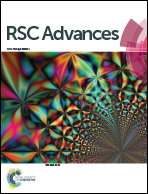Optical, dielectric, electronic and morphological study of biologically synthesized zinc sulphide nanoparticles using Moringa oleifera leaf extract and quantitative analysis of chemical components present in the leaf extract
Abstract
The biosynthesis of zinc sulphide nanoparticles with ∼30 nm diameter using the leaf extract of Moringa oleifera is reported here. The biosynthesized nanoparticles exhibit high stability for a period of three months as supported by the observed negative zeta potential values of 45–55 mV. Two peaks were observed at 427 and 560 nm in the photoluminescence spectrum of ZnS nanoparticles. The dielectrics as well as electronic properties of ZnS nanoparticles were systematically investigated. Thin-layer-chromatography densitometric technique was employed for the simultaneous quantification of the major chemical components present in the extract of M. oleifera leaves. The average amount of observed biomolecules such as crypto-chlorogenic acid, isoquercetin and astragalin were found to be 0.0423, 0.0467 and 0.0634% dry weight, respectively.


 Please wait while we load your content...
Please wait while we load your content...